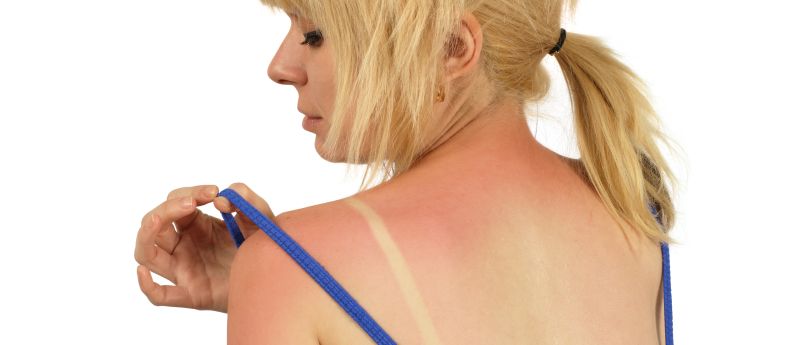
The Facts about Sun Protection
If you have ever played or worked under the scorching sun for an extended period of time without covering your skin, most likely you have experienced the discomfort of sunburn. Initially your skin turns red, followed by varying degrees of pain dependent on the severity; after a few days of agony and suffering, your skin starts to peel and return to normal. Then you forget all about it until you get burned again.
Sunscreen standards
If you enjoy sunshine but don’t want to deal with the pain caused by sunburn, regular use of a broad spectrum sunscreen with a sun protection factor (SPF) value of 15 or higher, in combination with other protective measures, is recommended. On sunscreen labels, SPF is always followed by a number such as 10, 15, or 20. This means a sunscreen with an SPF of 15 will delay sunburn setting in a person by 15 times. In other words, by applying the sunscreen, a person will start to burn after 150 minutes, while without sunscreen it would take only 10 minutes.
Developed in 1938 by chemist Franz Geiter, Gletscher Crème (Glacier Cream), was the first modern sunscreen; Geiter went on to introduce the SPF concept in 1962. SPF has since become the worldwide standard for measuring the effectiveness of sunscreen. Interestingly, the original Gletscher Crème had a modest SPF of 2. Early sunscreens only protected against sunburn, which is primarily caused by ultraviolet B (UVB) radiation from the sun. “Broad spectrum” sunscreens were created to protect against both ultraviolet A (UVA) radiation, which cause skin cancer and early skin aging, and UVB rays. Scientific data conclusively shows broad spectrum SPF 15 or higher products can reduce the risk of skin cancer, early skin aging and sunburn.
In addition to SPF, there are other methods for measuring sun protection efficacy. PPD (persistent pigment darkening) is a standard of measuring protection against UVA. Theoretically, sunscreens with a PPD rating of 10 allow a person 10 times as much UVA exposure as is recommended without protection. Asian brands, particularly Japanese ones, typically use the Protection Grade of UVA (PA) system, which is based on the PPD reaction and now widely found on the labels of many sunscreens. According to the Japan Cosmetic Industry Association, PA+ corresponds to a UVA protection factor between two and four, PA++ between four and eight and PA+++ more than eight. Therefore, choosing a sunscreen with PA+++ will provide you with the greatest protection.
Sunscreens come in two forms: physical and chemical. Physical sunscreens protect your skin from the sun by deflecting or blocking the sun’s rays using titanium dioxide or zinc oxide minerals. Conversely, chemical sunscreens work by absorbing or scattering the sun’s rays. Many chemical UV filters have not received Food and Drug Administration (FDA) approval in the United States, but are available in Europe and Asia.
Other protective measures
In addition to sunscreen, there are several other ways to protect yourself against the harmful effects of the sun:
- Limit time in the sun, especially between the hours of 10am and 2pm when the sun’s rays are the strongest.
- Wear clothing to cover skin exposed to the sun (long-sleeved shirts, pants, sunglasses and broad-brimmed hats) when possible.
- Use a water resistant sunscreen when swimming or sweating.
- Reapply sunscreen, even if it is labeled as water resistant, at least every two hours (Water resistant sunscreens should be reapplied more often after swimming or sweating, according to the directions on the label).
Certain drugs and herbal supplements can increase the risk of sunburn. These include sulfa-based drugs, antibiotics, tranquilizers, birth-control pills, arthritis painkillers, oral diabetes medications, St. John’s wort and allergy medications. People receiving treatment for cancer, high blood pressure, heart-rhythm problems, acne and other skin-condition conditions may also be at increased risk. If you are taking photosensitizing drugs, be sure to use a broad-spectrum sunscreen; drug-induced photosensitivity is primarily due to UVA rays.
Treating sunburn
If you are suffering from sunburn, take these steps to ease your pain:
- Use over-the-counter (OTC) pain relievers (e.g. Aspirin, Tylenol, Motrin, etc.) to lessen any discomfort and pain.
- For mild sunburn, use a cool compress with equal parts milk and water.
- Moisturize the affected area with aloe-based lotions, or use gel directly from an aloe plant.
- Take cool (not ice-cold) baths, but avoid bath salts, oils and perfumes to prevent sensitivity reactions.
- Don’t scrub or shave the skin or use lotions with topical anesthetic medications, as this may result in sensitized skin or allergic reactions.
- Stay out of the sun while you are healing and drink plenty of fluids.
Other facts
Be aware that no sunscreen is completely “waterproof.” As they all eventually wash off, sunscreens can only be labeled as “water resistant.” Sunscreens labeled as water resistant are required to state effectiveness when swimming or sweating. All sunscreens are also required to provide directions on when to reapply according to U.S. FDA regulations, but a good basic rule is to reapply sunscreen at least every two hours. Clothing protection can also be measured by SPF; typical summer clothing provides only an SPF of up to 6.5, but specialized sun-protection clothing can protect up to 30 times than normal.
Armed with these facts, have a safe and sunburn-free summer!
Reference:
Copyright United Family Healthcare 2018 All right reserved ICP 京ICP备13017554号-4




